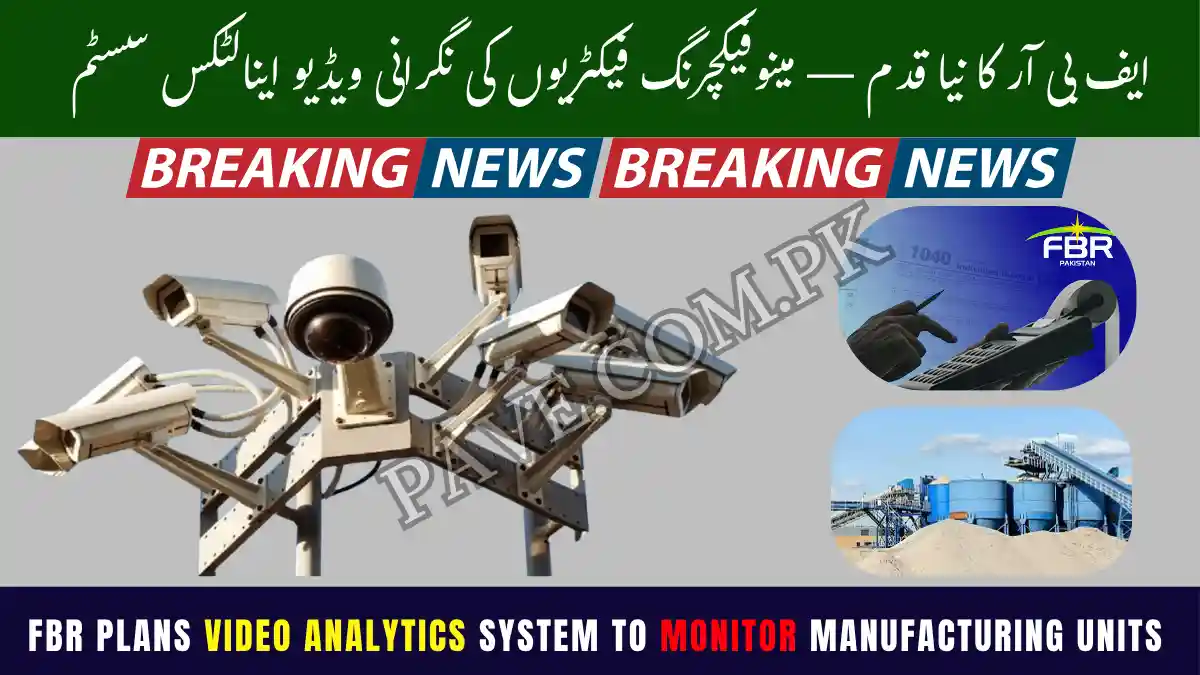FBR Plans Video Analytics System to Monitor Manufacturing Units
The Federal Board of Revenue (FBR) is preparing to introduce an advanced Video Analytics System to monitor manufacturing units across Pakistan — a move aimed at enhancing transparency, ensuring tax compliance, and modernizing industrial oversight. This initiative is being evaluated as part of the government’s broader plan to strengthen digital tax compliance and reduce revenue leakages within key sectors of the economy.
Sources familiar with the development told ProPakistani that the FBR’s upcoming system, referred to as the FBR Video Analytics System, will leverage artificial intelligence (AI) and smart surveillance technology to count, record, and analyze production in real time, offering unprecedented visibility into manufacturing operations.
A New Step Toward Digital Oversight
According to officials, the new system represents a major component of the FBR Smart Surveillance 2025 strategy — an ambitious effort to integrate automation, data analytics, and real-time monitoring into Pakistan’s tax infrastructure.
The Video Analytics Pakistan Industry initiative will involve the installation of high-definition cameras at key production points within factories. These cameras will be connected to AI-powered analytics platforms that automatically detect production patterns, track volume, and transmit live data to FBR’s centralized monitoring servers.
The move aims to eliminate manual reporting and bring greater transparency and accountability to sectors where tax evasion through underreporting of production has remained a long-standing issue.
An official at the FBR explained, “We are moving toward a smarter, data-driven compliance regime where technology ensures fairness, reduces corruption, and builds trust between industries and regulators.”
Complement or Replacement for the Track and Trace System?
Currently, Pakistan’s manufacturing oversight relies heavily on the Track and Trace System (TTS) — a program that uses secure, machine-readable tax stamps affixed to products to ensure traceability from production to retail.
The FBR is now exploring whether the Video Analytics System should act as a complementary technology to the TTS or serve as an alternative monitoring mechanism for selected industries.
While the TTS provides end-to-end traceability through physical fiscal stamps, the video analytics system would instead use visual data and AI recognition to determine the number of goods produced.
Both systems have distinct strengths:
- Track and Trace System ensures product authentication and tax stamp verification, preventing counterfeiting and illegal trade.
- Video Analytics focuses on real-time production monitoring, offering instant insight into manufacturing trends and potential discrepancies.
Analysts suggest that a hybrid model, combining both systems, could yield the highest level of compliance and operational efficiency.
Read More: PIA Restarts UK Flights After 5 Years
How the FBR Video Analytics System Will Work
The proposed FBR Manufacturing Monitoring framework will rely on AI-integrated surveillance cameras strategically placed across production lines.
Key features include:
- Automated Product Counting: Cameras use motion detection and object recognition to count each item as it moves along the line.
- Centralized Data Transmission: Footage and analytical data are transmitted directly to FBR’s monitoring system in real time.
- AI-Powered Alerts: The system can detect anomalies, such as sudden production spikes or operational downtimes, prompting immediate inspection.
- Digital Dashboard Integration: FBR officials will access production data through a secure online dashboard linked to tax compliance systems.
By creating a digital production trail, this system minimizes the need for manual intervention, reduces opportunities for misreporting, and enhances the FBR’s ability to assess accurate tax liabilities.
Potential Benefits of the Video Analytics Plan
If implemented effectively, the FBR Factory Monitoring Plan could revolutionize industrial regulation in Pakistan. Among its anticipated benefits:
- Increased Production Transparency: Every stage of manufacturing will be visible to regulators, reducing under-declaration.
- Enhanced Tax Compliance: Real-time data ensures companies pay taxes based on accurate output figures.
- Operational Efficiency: AI analytics can identify bottlenecks or inefficiencies in production lines.
- Reduced Human Error and Corruption: Automated systems remove the dependency on manual inspections.
- Broader Economic Impact: Improved compliance leads to greater national revenue and a more level playing field for law-abiding businesses.
These changes align with FBR’s long-term goal of building a digitally governed, tax-compliant industrial ecosystem by 2025.
Industry Response — Optimism Mixed With Caution
The manufacturing sector has responded to the proposed initiative with a mix of optimism and apprehension.
Many industrialists welcome the FBR’s shift toward digital monitoring, calling it a “forward-thinking move” that could simplify regulatory compliance. However, some have raised concerns about data privacy, implementation costs, and the lack of traceability in a purely video-based system.
A senior executive from the cement industry commented, “Video analytics can certainly improve transparency, but it doesn’t replace the deterrence effect of physical tax stamps that the Track and Trace System provides.”
Industry experts recommend that the Video Analytics System should complement the TTS rather than replace it. This hybrid approach would retain the benefits of product authentication while providing additional insights into production line efficiency and factory operations.
Read More: Punjab Govt Orders Surrender of Illegal Weapons Within 15 Days
FBR’s Broader Digital Transformation
The FBR Digital Tax Compliance agenda has been one of the most ambitious reforms in Pakistan’s public sector. Over the past few years, the Board has rolled out multiple technology-driven initiatives to improve documentation, transparency, and enforcement.
These include:
- Expansion of the Track and Trace System across high-risk sectors (tobacco, fertilizer, cement, sugar).
- Introduction of e-Invoicing to digitize business-to-business transactions.
- Development of real-time reporting dashboards for tax officers.
- Pilot programs for AI-assisted audit systems and risk analysis.
The planned Video Analytics Pakistan Industry initiative is a natural extension of these efforts, aiming to integrate cutting-edge AI and machine vision technology into the regulatory ecosystem.
Challenges and Limitations
Despite its potential, experts note several challenges that must be addressed before implementation:
- Lack of Product Authentication: Video systems cannot mark or authenticate products, limiting their use for tracking tax-paid items beyond the factory gate.
- Data Storage and Security: Handling and securing vast amounts of video data will require advanced IT infrastructure and cybersecurity safeguards.
- Implementation Costs: Factories may face high costs for camera installation, AI calibration, and system maintenance.
- Technical Training: FBR and industry staff will need specialized training to interpret analytics data effectively.
- Legal Framework: Existing tax laws may need amendments to formally recognize video-based monitoring as a compliance standard.
Officials stress that these challenges are being thoroughly assessed as part of the feasibility review process before any final decision is made.
Global Context — Pakistan Following an International Trend
The idea of using AI-based video monitoring for industrial oversight is not new. Several countries, including Turkey, Brazil, and Malaysia, have adopted hybrid compliance systems that combine fiscal marking, IoT, and AI-driven analytics.
These systems have shown success in improving transparency while maintaining tax enforcement standards. Pakistan’s adoption of a similar model under the FBR Smart Surveillance 2025 plan could bring it closer to international best practices.
Experts believe that implementing a dual approach — merging TTS and video analytics — will ensure that Pakistan benefits from both traceability and technological modernization, paving the way for a digitally intelligent tax ecosystem.
Read More: Islamabad Gets New Padel Tennis Court and Fitness Arena
The Road Ahead
The FBR Video Analytics System is currently in the evaluation and planning phase, with input being gathered from technology vendors, industry associations, and policy experts.
If approved, the system will likely be piloted in selected manufacturing sectors before being rolled out nationwide. The pilot phase will test its accuracy, scalability, and compatibility with existing FBR databases and monitoring tools.
According to insiders, the FBR aims to finalize its decision by early 2026, following successful trials and stakeholder consultations.
Conclusion
The FBR Plans Video Analytics System to Monitor Manufacturing Units marks a pivotal moment in Pakistan’s move toward digital tax governance. By embracing AI-powered monitoring, the FBR aims to strengthen industrial compliance, minimize tax evasion, and modernize its regulatory oversight.
However, experts caution that true effectiveness will depend on whether the new system is integrated strategically — not as a replacement for the Track and Trace System, but as a technological enhancement that brings together efficiency, verification, and transparency.
As the FBR Manufacturing Monitoring plan progresses, Pakistan stands at the cusp of a transformation that could redefine how industries are supervised — shifting from manual oversight to intelligent, data-driven governance built for the future.







